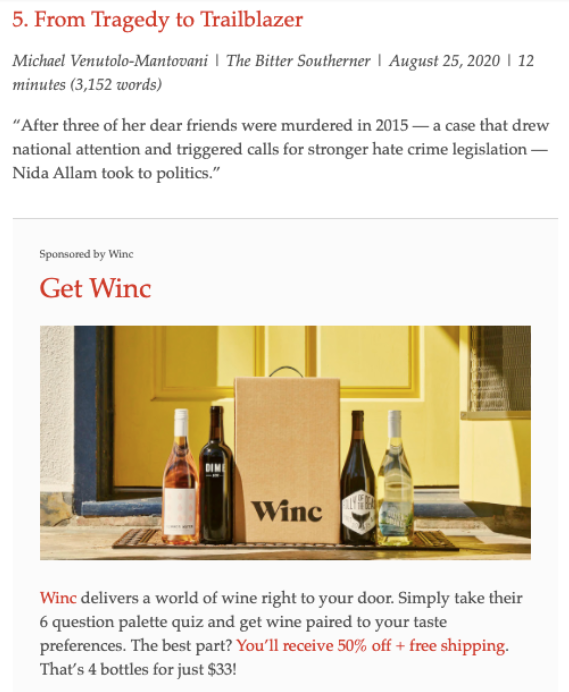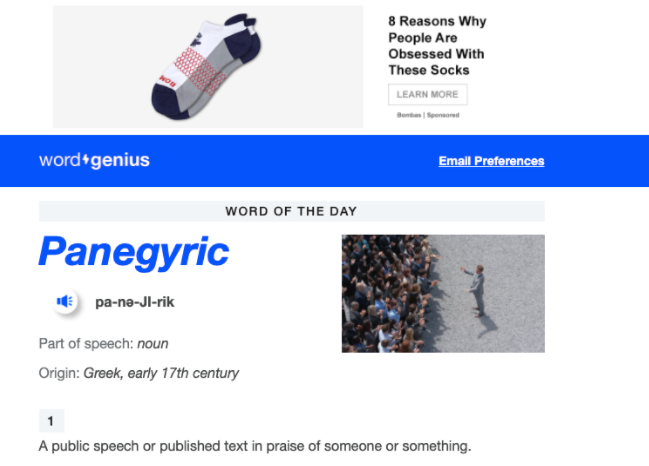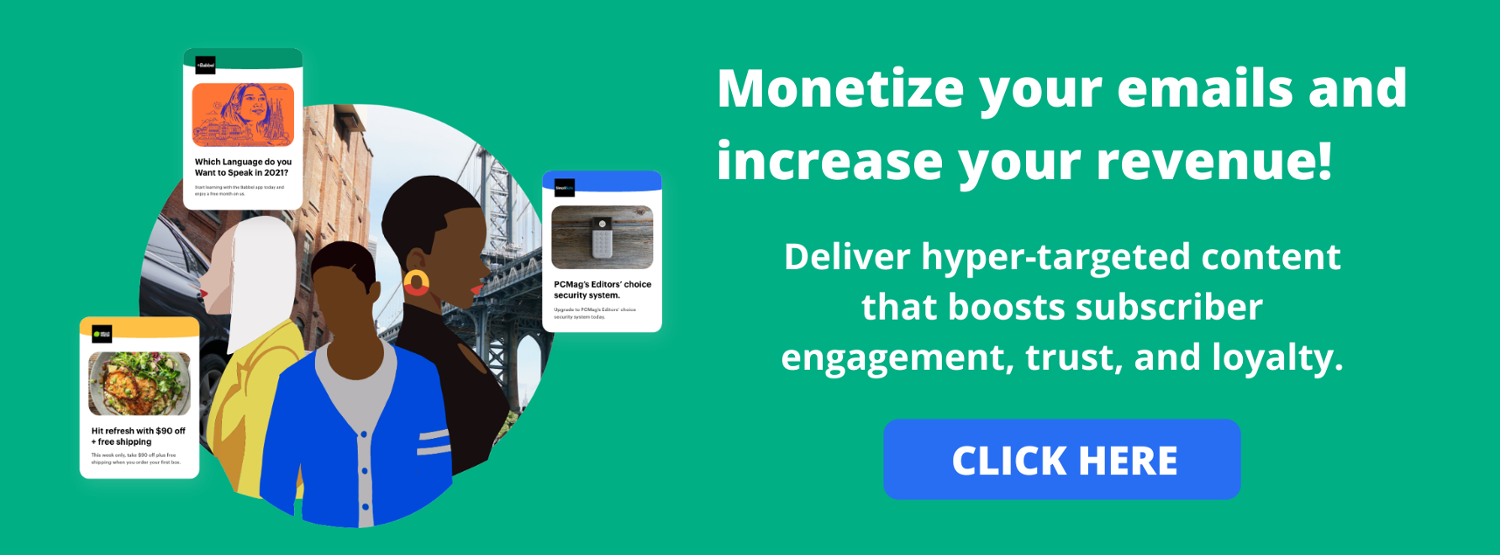Looking back, email hasn’t usually been the top choice as far as advertising goes. As such, email advertising presents a fresh new path for publishers who deal with all sorts of challenges.
From fighting to keep up with new ad formats and technology, to their reliance on social media to expand audience reach, publishers are now discovering email advertising as a viable solution.
The numbers are there: email has a 4X higher median ROI than social media or paid search. What makes email advertising appealing to many publishers is the fact it doesn’t eat into existing revenue streams and actually supports core business activities. It also drives long-term value from the customer, as well as provides more interesting, dynamic, and relevant content that leads to higher engagement overall.
Unlike the web and other mediums, email advertising doesn’t suffer from the same ad fatigue levels. Still, that doesn’t mean you should go head-first – that’s not how it works.
In this article, we’ll take a look at a few email advertising examples and what makes them so good.
But first…
What is email advertising?
Email advertising is the process of creating and distributing promotional content via email newsletters. As a note, it’s not the same as email marketing, which is the process of creating and distributing organic email content to inform, educate, nurture or entertain readers. An email newsletter itself, for example, is often a type of email marketing. Whereas ads placed within the email newsletter – either through direct-sold or programmatic channels – is a type of email advertising.
Email advertising can be a valuable and engaging revenue stream for publishers, especially those trying to make up for lost advertising revenue on their websites.
Why is email advertising so effective? Because it reaches consumers on a direct, opt-in channel where they’re already eager to consume new content. After all, if you work hard to gather those email addresses and drive sign-ups, you deserve an opportunity to put that email list to work.
Since people sign up to receive emails, publishers can also assure advertising partners that they’ve earned their readers’ trust and their email campaigns are reaching only the most relevant, interested consumers.
As MarTech Series reported, the #1 reason subscribers open and read email newsletters is because they trust the publisher. Two-thirds of subscribers even say that trust is more important than the email content itself.
Email advertising examples
The road to successful email advertising is paved with successful campaigns that you can learn from. When building your email marketing campaigns and strategies, consider these standout email advertising examples from publishers and advertisers who’ve done it right.
Longform journalism curator, Longreads.com, sends weekly newsletters featuring its top five articles. Among this organic content is a call to action for donations and, you guessed it, an advertisement. This ad, sponsored by Winc, invites readers to receive 50% off their first order. It can also be considered a native ad, since it matches the surrounding email design, including the color palette and font.

Home design publication, Houzz Magazine, also nails its native ads in email campaigns. Like Longreads, Houzz sends subscribers its most popular, trending stories each week. Nestled among those organic stories are sponsored stories from advertising partners. They look the same as the rest of the email marketing content, aside from an obligatory “Sponsored Story” disclaimer above the headline.

WordGenius, on the other hand, programmatically places banner ads in the top and middle of its email newsletters to reach target audiences with content that matches their behaviors and interests. So while the ads may not be related to the email newsletter itself (i.e. the word of the day), they are still related to the most important part of this equation: the consumer.
These display ads also include clear calls to action like “Learn More” and “Shop Now,” inviting users to click through and explore these products further.

Email advertising case studies
Digging even deeper, let’s dive into some data-rich case studies from effective email advertising campaigns.
Niche publisher drives 15% of revenue
French Morning Media, the leading media outlet for French speakers in the U.S., runs weekly newsletters for over 120,000 subscribers. As a growing publication, they saw an opportunity to diversify their revenue mix and deliver greater value to their niche community of readers.
So, they started to run their on-site banner ads in their email newsletters as well. They were able to seamlessly deliver its direct-sold inventory through email — with just a single line of code in its template.
As a result, email ads now account for 15% of the publisher’s total revenue. They also have a high open rate of a whopping 35%, so they can tap into that engaged audience and help advertisers promote specific products through targeted emails.
Local news outlet backfills unsold ad inventory
The Press Democrat, a leading news resource in California’s Bay Area, delivers 17 different newsletters to over 100,000 email subscribers. To increase revenue, they started selling direct ads in their email newsletters.
They were able to build templates with a range of ad sizes and even programmatically backfill inventory via Google Ad Manager, so valuable ad real estate never went unsold. Not to mention, they got the ability to track clicks and impressions easily through a comprehensive analytics feature, so they know just how their ads are performing.
Now, all 17 of The Press Democrat’s newsletters are monetized, generating 85% direct-sold and 15% programmatic revenue from a slew of email campaigns.
Sweepstakes platform monetizes 300,000 subscribers with email ads
Daily deal, trivia, and sweepstakes platform, Dealmaxx, delivers three different daily emails to a collective 300,000 subscribers. The company wanted to make sure they were monetizing that opt-in audience through email advertising.
They started to deliver hyper-targeted ads based on each user’s browsing behaviors, location, and device. In fact, it’s so effective that they don’t even use direct-sold ads; 100% of their inventory is filled programmatically.
The result? Dealmaxx drives thousands of dollars in incremental revenue each month. It even helps them make up for money lost from ad blockers that people use on their site.
Best practices for optimizing email marketing campaigns
In addition to the examples above, use these best practices to guide your email marketing strategies, so you can drive the most revenue from your efforts – and make those advertising partners happy with higher clickthrough rates.
Balance out the ad and non-ad content
To make the most of your emails (in other words: monetize them), displaying an ad or two is always a good idea. Why? Because advertisers are just waiting to work with you, even if you don’t realize it quite yet.
As a publisher, you have a direct link to a specific audience. Your niche is the same as that of an advertiser who would love nothing more than to reach your audience. And the best thing about it is that you don’t have to cut off a sizeable piece of your email to accommodate a flashy ad that screams “look at me!”. You can place ads in an unobtrusive way that adds value rather than interrupting the user experience. In other words you can use native advertising for your email advertising efforts.

See how the ad seamlessly fits into the Kitch Daily’s newsletter above without being intrusive? The design works in everyone’s favor. You should tread lightly so that ad placement doesn’t affect content engagement negatively. In this regard, publishers have the option to partner with a platform that can help them find a perfect advertiser in order to create more value for subscribers which will eventually pay off.
This means customizing email advertising to fit all case uses: the type, number, and placement of ads. Maybe you like what native advertising brings to the table. Maybe you prefer to stick with the standard display sizes. The idea is to choose adverts that are as interesting and valuable as the content.
We can’t tell you what the ideal ad to non-ad content ratio is because some publishers look to focus on the content and use email advertising as a supplement to it while others make advertising their primary goal. However, we can tell you this: test every aspect of your ads to specifically optimize for metrics that matter to you. Providing a suboptimal experience to your subscribers is a sure way to lose them.
Avoid being too spammy or direct
The subscriber is the most important asset a publisher has. Ads, regardless of their form and size, should always reflect what the subscriber is most interested in.
In that respect, publishers need to embrace platforms that are committed to the cost-per-click model where ads are displayed only when it has proven to have received clicks. It’s about being respectful of your subscribers.
Advertising should revolve around the content and not the other way around. That means different adverts tailored for different newsletters and audience segments.
An example below shows how ads can add value to The New Yorker provides suggestions and recommendations without forcing it:

Image credit: GetResponse
Let’s put it this way: content with more clicks allows a continuous flow of feedback on how content resonates with the audience. By measuring those all-important metrics like click-through rate, deliverability, and unsubscribe rate, you can make sure the ad content is firmly in line with the rest of the newsletter.
Simply find advertisers that bring tangible value from those who randomly chase readers and maintain your reputation as a credible publisher.
Relevance is crucial in email advertising
As the often-quoted Spider-Man phrase says: “With great power comes great responsibility.” Your responsibility here is not as exciting as fighting crime but arguably equally important in its respective manner: to be relevant at all times.
Fortunately, technology has advanced far enough for you to choose what type of ads and advertisers you want, as well as which categories make the most (or little) sense. Then, you can further filter by keywords, titles, and even images.
Email is innately cross-device: no matter what that device is, it works flawlessly. Hence, real-time factors such as the location, time of open, and the device itself play an important role in delivering the right ad to the right person at the right time.
In terms of relevant content, individual users’ prior click behavior is at the center, leading to more revenue and success for publishers. The process is automated as an algorithm recommends content based on the click history and, thanks to machine learning, continuously learns and improves based on fresh clicks.

You might have noticed that the second image in this text is credited to GetResponse. See the ad on the upper right? That’s relevancy based on click history at its finest.
Additionally, different ads are shown each time a user views the email, making each impression count monetization-wise and is tailored based on the user’s interest and intent. Therefore, instead of being a one-trick pony, ad content is constantly relevant and adding value.
Final words
Email advertising is a bonafide option for every publisher because ads are always relevant with the right platform. This is especially beneficial for content-oriented newsletters where ads seemingly blend in with content through native advertising.
With email, advertising it is specifically tailored to a unique user, allowing content to be equally specific to the recipient. In the world of online advertising, that’s as good as it gets.




